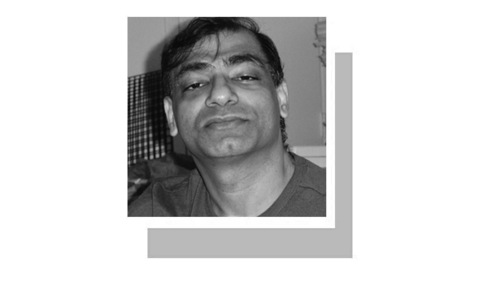
The ‘Lines of Inquiry’ show’s curator, Nusrat Khawaja, calls for investigating the imagination without “the rigid forms of ideologically imposed thinking, challenging the linearity of a chronological narrative.”
Her background in activism, with education in cultural anthropology, allows for a wider perspective to view art. Khawaja documents this diversity in an accompanying catalogue in a crisp design by Sabiha Imani.
This unexpected sharing of space by 16 invited artists challenges the viewer’s perception of both the content and historical context of the art. How do these different bodies connect to line? Are these works transitional or are they representative of each artist’s oeuvre? How have the connections between the works been investigated by the curator? Line is usually equated to drawing, and the works provide an uneven ground for study. These may be possibilities to consider given this window of inquiry.
We can view this as a moment to pause and engage with the structure representative of diverse artistic styles. Drawing lays bare the hidden and is like an informal visual note. A line is also the birth of an idea, the companion of many an arduous journey. One wishes that there were a glimpse of a preparatory phase, in a more creative response to the curator’s call.
A recently held exhibition of works commemorated 75 years of art in Pakistan and the evolution of select artists
Adeel-uz-Zafar is the only artist who has departed from his trademark imagery by exploring sound in his process. He generally draws by scratching on to a black surface that reveals a negative white image of large-scale stuffed toys wrapped in gauze. Zafar extracts the sound of the crisscross mark marking, inviting viewers to create drawings in response. The sound work appears almost subversive in its informality and spontaneity in comparison to the more mundane finished works on view.
Two works on paper by Meher Afroz evoke the feeling of age-old manuscripts. No matter what the call, Afroz’s imagery finds itself conversing with the marsiya [elegy]. Her colours are drenched in hues of lamenting indigos. In the Dastawez Series (2007), she read Faiz Ahmad Faiz’s Waadi-i-Sina (1971) as a present-day marsiya. Text was embedded within layers of paper built by hand.
The works in the current show are titled Azmaaish, although she also thought of re-naming them Safbandi. Safbandi is the formation of worshippers in collective prayer. She attributes line to the strength of the namazis, and as the raah-e-mustaqeem [the straight path]. The words yaqeen [belief] and imaan [faith] inscribed on silver leaf, gleam through the dark blues like moonlit reflections. Hundreds of pieces of the built surface are sewn into a composite.
The subtlety of this is, however, dwarfed by the large canvas by Unver Shafi on one side, and by the strong black lines and orange in Mohammad Zeeshan’s grid-like map. Both of those are powerful works, but the conversation here seems to go in disparate directions.
Our view shifts from a large 6ft x 5ft luminous Unver Shafi canvas from 2020, to the aged pencil-and-ink sketches by Rasheed Araeen from 1955. These are the two highlights that hold the show for me.

Araeen’s are informal sketches from his college days in Karachi, that he had stacked away in his studio in Nazimabad for more than 60 years. A faint charcoal sketch is titled Parween, from the Artists’ Club in 1956. Araeen, along with the late Masood Kohari were members of this club and used to have life-drawing sessions. Other spontaneous works, such as a watercolour-and-ink of Pakistan Day celebrations, from 1955, for a Burmah Shell greeting card, are absolute gems. This was the beginning of Araeen’s line that evolved into complex structures.
Shafi started exhibiting in the early 1990s and displayed exclusively at Ali Imam’s Indus gallery and at Chawkandi. The late art historian Dr Akbar Naqvi, who is also to be commemorated here, held Shafi in high esteem. In his book Image and Identity, Dr Naqvi wrote that Shafi was “interested in the tensions between colour plates and joined canvases painted in different styles in such a manner that one questioned the other.”
Shafi’s large-scale, free-floating shapes were luminous and of an uncharted realm. The work currently on view encapsulates the majesty of Shafi’s form, where two rectangles join to create a line. It is precise and razor-sharp, only to disappear if the canvases were to be separated. The painted form is closest to a poetic interlude in classical Western music, like the tensions essential to the maintenance of compositional drama. Shafi has been on a solo flight, a monologue that has not found conversations of its calibre.
Works by Khadim Ali, Akram Dost Baloch, Farazeh Syed, Laila Rehman, Mohammad Ali Talpur, Ruby Chishti, Irfan Gul Dahri, Ayessha Quraishi, RM Naeem, Mohammad Zeeshan, Munawar Ali Syed, Humana Tal Bushra form a cluster. Drawings and prints by Sadequain, Bashir Mirza, Shahid Sajjad and Zarina Hashmi have been added later, but were not part of the curatorial structure.
Each of the works belong to different spaces and aspirations, and they hold a special connection to this gallery, which has witnessed the evolution of these journeys. Coming to Chawkandi Art is like coming home.
‘Lines of Inquiry’ was exhibited at the Chawkandi Art Gallery, Karachi, from August 13-September 17, 2022
Published in Dawn, EOS, September 25th, 2022














































Dear visitor, the comments section is undergoing an overhaul and will return soon.